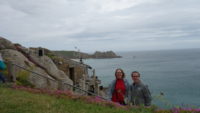 We certainly felt blessed today by the surprisingly tour-able weather. The forecast had called for high winds and rain all day, and while there were some pretty intense winds, we had almost no rain until 5:00, and then only for an hour, and that was when we were in the car.
We certainly felt blessed today by the surprisingly tour-able weather. The forecast had called for high winds and rain all day, and while there were some pretty intense winds, we had almost no rain until 5:00, and then only for an hour, and that was when we were in the car.
Mer was in charge today, and she wanted to follow a recommended drive in her tour book. So we set off on a day of broad skies and narrow roads. Our first stop was the postcard village of Mousehole. It is a small fishing village west of Penzance, and I loved it. It is a walkable town, with narrow streets (as I found out later trying to leave) that invite wandering. It has a small artificial harbor with the village huddled around the sea. It’s full of cute shops and great views, and even a Victorian rock pool which traps sea life in it once the tide goes out (for viewing – they can leave again next high tide). We wandered the town for about an hour, ducking into one shop and swinging by an ice cream shop. I have to say that adding clotted cream to ice cream is a fabulous idea.
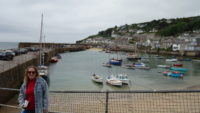 We then drove (and prayed) down to Lamorna Cove. One Cornish man we met told me even the Cornish folks try not to drive down to the cove. But, like Mousehole, it was a beautiful spot, but with only half a dozen houses and a cafe. It also has access to the South West Coast Path, England’s longest hiking trail. We set off in one direction, looking to hike a short ways. We got to some sign that said more or less, “Abandon all hope, ye who enter here.” We turned around. We went the other way, which was past the half-dozen cute houses and had a stream we crossed. We made our way up a moderately steep trail, and as we started to make some real distance, we heard thunder. There was no rain, but it seemed like climbing up to the top of an exposed cliff with lightning around was a bad idea. We turned around. We went to the cafe, where we got pastry bars. We sat down.
We then drove (and prayed) down to Lamorna Cove. One Cornish man we met told me even the Cornish folks try not to drive down to the cove. But, like Mousehole, it was a beautiful spot, but with only half a dozen houses and a cafe. It also has access to the South West Coast Path, England’s longest hiking trail. We set off in one direction, looking to hike a short ways. We got to some sign that said more or less, “Abandon all hope, ye who enter here.” We turned around. We went the other way, which was past the half-dozen cute houses and had a stream we crossed. We made our way up a moderately steep trail, and as we started to make some real distance, we heard thunder. There was no rain, but it seemed like climbing up to the top of an exposed cliff with lightning around was a bad idea. We turned around. We went to the cafe, where we got pastry bars. We sat down.
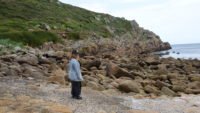 We skipped down another narrow lane to the small cluster of homes and six boats that make up Penberth Cove. All the boats were tied way up on the boat launch – this part of England has twenty foot tides. It was another spot to admire natural beauty while being off the beaten path. After sitting on a rock and listening to the ocean (and one occasionally baring dog), we headed on.
We skipped down another narrow lane to the small cluster of homes and six boats that make up Penberth Cove. All the boats were tied way up on the boat launch – this part of England has twenty foot tides. It was another spot to admire natural beauty while being off the beaten path. After sitting on a rock and listening to the ocean (and one occasionally baring dog), we headed on.
We spent the bulk of the afternoon in the village of Porthcurno. It is home to perhaps the most improbable and the most dramatically situated outdoor theater in the world. The Minack Theatre is carved into the cliffside overlooking the ocean and more cliffs. Despite the challenges of performing on the Cornish coast, the stage and all the seating are outdoors. Sets often have to be anchored down, and the sound system has a “loud ocean” setting for the soundbooth. Plays are changed out every week during the six-month season.
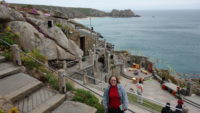 The theater is largely the work of one woman, with the help of three men. Rowena Cade came from a wealthy family and moved to Cornwall with her mother. When she was in her thirties, a friend got her involved in making costumes for local theater productions. When her friend wanted to stage The Tempest, Rowena offered her cliff garden as a setting. She, with the help of her one gardener, spent six months clearing the ground on the cliff, cutting rough terraces for seating, and filling in a level area for the stage. The play was a huge success, not the least for the setting. Thus the Minack Theatre was born, and Rowena continued to work on the theater with her gardener (and two others after he passed away in the 1960s) for fifty years. Now, the theater can seat seven hundred people and is run by a non-profit. It’s amazing what one determined woman can do, and it’s a pretty great legacy. We’ll be seeing The Odyssey there on Monday – it should be special. Today, we toured the place and learned about it.
The theater is largely the work of one woman, with the help of three men. Rowena Cade came from a wealthy family and moved to Cornwall with her mother. When she was in her thirties, a friend got her involved in making costumes for local theater productions. When her friend wanted to stage The Tempest, Rowena offered her cliff garden as a setting. She, with the help of her one gardener, spent six months clearing the ground on the cliff, cutting rough terraces for seating, and filling in a level area for the stage. The play was a huge success, not the least for the setting. Thus the Minack Theatre was born, and Rowena continued to work on the theater with her gardener (and two others after he passed away in the 1960s) for fifty years. Now, the theater can seat seven hundred people and is run by a non-profit. It’s amazing what one determined woman can do, and it’s a pretty great legacy. We’ll be seeing The Odyssey there on Monday – it should be special. Today, we toured the place and learned about it.
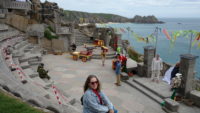 Porthcurno has also been a communications hub. At one point, the village had fourteen international telegraph lines coming into it. It was so important that in World War II, all the telegraph operations were moved into two bunkers carved into the mountain specifically to protect communications. Three hundred men guarded the place, and automated flame throwers were installed on the beach. Nowadays, Porthcurno still has multiple fiber optic lines come ashore here. We learned all of this at the Telegrah Museum, which presents the history of the telegraph and how that evolved into modern communications. The museum includes the two bunkers, and it has examples of all of the equipment used for telegraphs, dating back to the 1860s. We spent an hour and a half in the museum, and could have spent another hour or so, but we closed the space out.
Porthcurno has also been a communications hub. At one point, the village had fourteen international telegraph lines coming into it. It was so important that in World War II, all the telegraph operations were moved into two bunkers carved into the mountain specifically to protect communications. Three hundred men guarded the place, and automated flame throwers were installed on the beach. Nowadays, Porthcurno still has multiple fiber optic lines come ashore here. We learned all of this at the Telegrah Museum, which presents the history of the telegraph and how that evolved into modern communications. The museum includes the two bunkers, and it has examples of all of the equipment used for telegraphs, dating back to the 1860s. We spent an hour and a half in the museum, and could have spent another hour or so, but we closed the space out.
 As a little quirk, there is a huge squid made of PVC flexible piping outside the museum. If you talk into one of the tentacles, the sound will come out for a listener who sticks her head in the eye of the squid. Meredith said it worked well.
As a little quirk, there is a huge squid made of PVC flexible piping outside the museum. If you talk into one of the tentacles, the sound will come out for a listener who sticks her head in the eye of the squid. Meredith said it worked well.
About at this point was when the hard rain started, continuing while we were seeking, and eventually finding, Cape Cornwall (after one missed road detour). It looked lovely, with a high cliff rising above both the sea and the parking lot. It looked like a great place to hike up, but the heavy rain and howling winds kept us in the car. We sat and watched the waves for several minutes, and then made our way back to Penzance for supper.
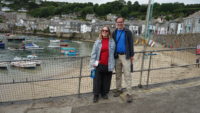 Mer’s first choice for a restaurant no longer existed (a new place had opened there instead), so she let me pick a place. I chose Admiral Benbow, a pirate/smuggler-themed restaurant. It was rambling inside, and as we tried to find a table that wasn’t reserved, we made our way all the way to the back, which was a full replica of the inside of a ship. I loved it.
Mer’s first choice for a restaurant no longer existed (a new place had opened there instead), so she let me pick a place. I chose Admiral Benbow, a pirate/smuggler-themed restaurant. It was rambling inside, and as we tried to find a table that wasn’t reserved, we made our way all the way to the back, which was a full replica of the inside of a ship. I loved it.
So ended our shipshape touring day. We may or may not get so lucky tomorrow with the weather, but today was a good day.